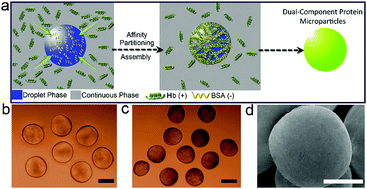Development of dual-component protein microparticles in all-aqueous systems for biomedical applications†
Abstract
Protein microparticles assisted by an emulsion droplet template have shown great promise in drug/cell delivery and tissue engineering, as well as diagnosis and treatment of diseases. However, the usage of non-aqueous solvents involved in the oil-containing emulsion and their single-component nature severely hamper their use in medical applications. To address these limitations, here we present a facile strategy to fabricate dual-component protein (DCP) microparticles via the microfluidic electrospray technique. Due to the affinity partitioning properties of the all-aqueous system (AAS), electrostatic complexation takes place between the two oppositely charged proteins to form dual-component protein–protein structures in the all-aqueous droplets. We demonstrate that hemoglobin–bovine serum albumin (Hb–BSA) DCP microparticles possess characteristics resembling those of natural red blood cells, including remarkable softness and the ability to pass through narrow channels. Moreover, in vitro results show that other hemoglobin–immunoglobulin (Hb–BSA) DCP microparticles exhibit good cytocompatibility towards human stem cells. Accordingly, this work provides a novel engineering strategy using all-aqueous droplets as a template to design new biocompatible DCP microparticles for biomedical applications.



 Please wait while we load your content...
Please wait while we load your content...